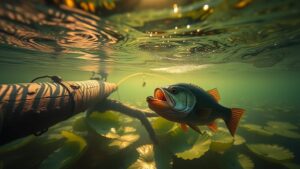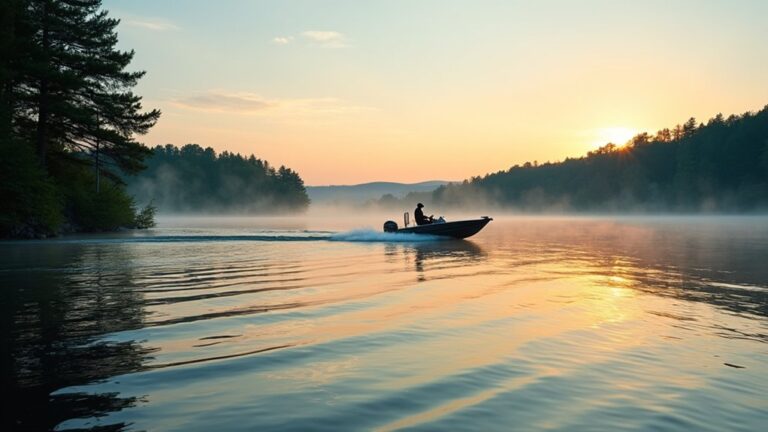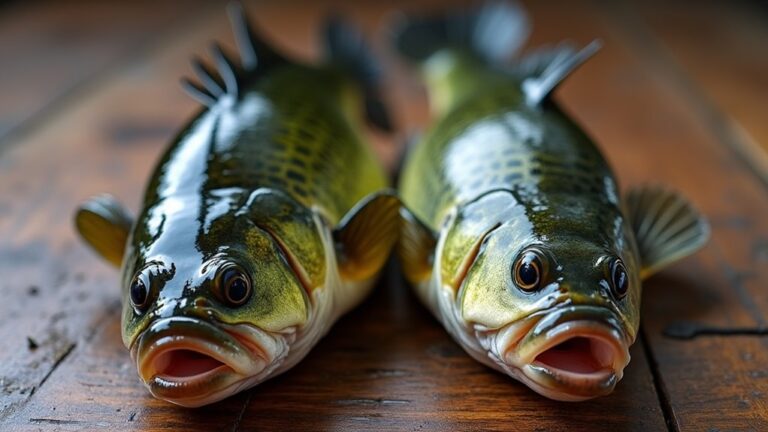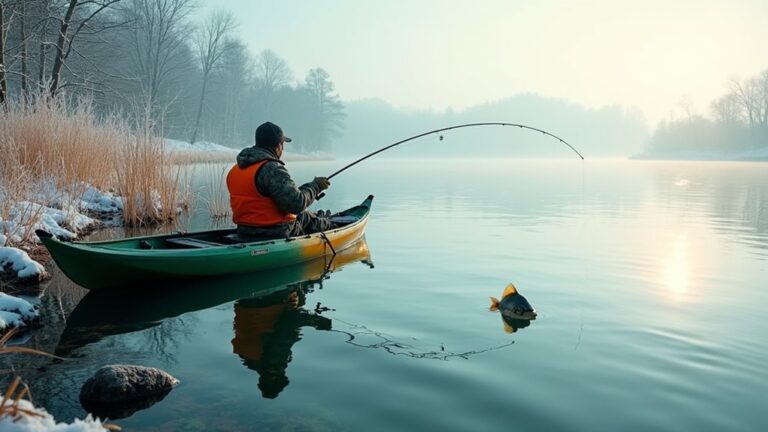To master bass fishing like a pro, you'll need to focus on seven key areas: understanding seasonal patterns, reading water conditions, choosing the right reaction baits, perfecting cast accuracy, adapting techniques throughout the day, recognizing feeding behaviors, and maximizing your time on the water. Success comes from knowing that bass prefer temperatures between 60-75°F and are most active during dawn and dusk. You'll want to target structure like fallen trees and rocky points, while matching your lure colors to water clarity. These fundamentals will put you on the path to landing more impressive catches, but there's much more to explore.
Mastering Location and Seasonal Patterns
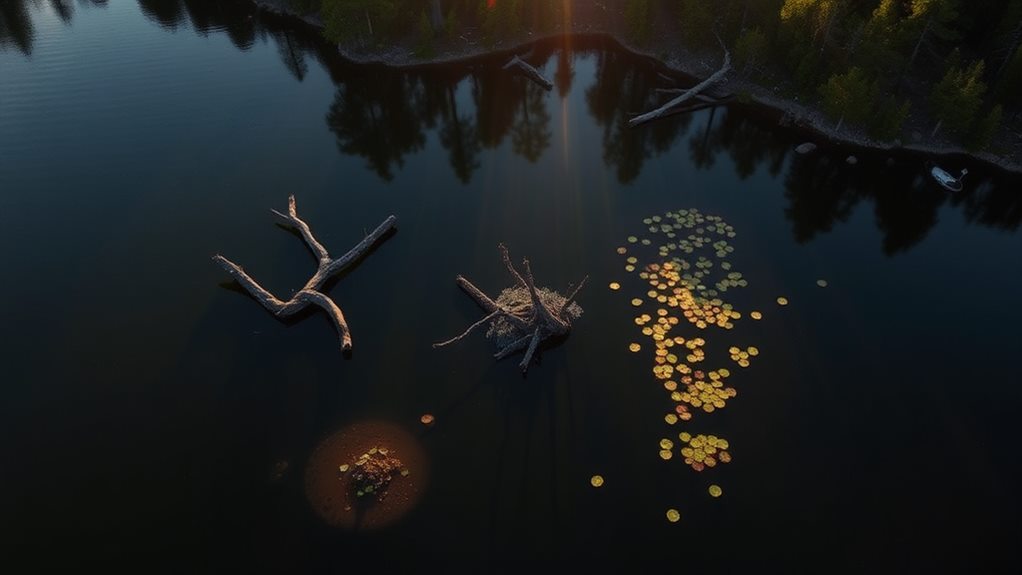
While many anglers focus solely on their gear and techniques, understanding bass location and seasonal patterns is the cornerstone of consistent success.
To catch bass consistently, you'll need to think like a fish and adapt your approach as conditions change throughout the year. Using polarized sunglasses will help you spot underwater structure and actively feeding fish more effectively, especially on sunny days.
Your success starts with recognizing how bass behave during different seasons. In spring, you'll find them in shallow waters as they prepare to spawn, actively feeding when water temperatures hit that sweet spot between 60-75°F.
As summer arrives, they'll retreat to deeper, cooler waters, while fall brings them back to the shallows for aggressive feeding.
To maximize your chances, focus on prime fishing times during low-light conditions at dawn and dusk, when bass are most active.
You'll want to pay special attention to structure and cover – think fallen trees, rocky points, and vegetation edges. In clear water, bass often stick close to these hiding spots, using them as ambush points for prey.
Remember to look for depth changes and shifts, as bass love hanging around these natural edges where they can quickly move between shallow and deep water as needed.
Reading Water and Weather Conditions
Success on the water goes beyond knowing bass locations – you'll need to master reading water and weather conditions to consistently land fish.
When you understand how water clarity affects bass behavior, you can make smarter lure choices, opting for natural colors in clear water and bolder options in murky conditions.
During warmer months, night fishing success increases dramatically as bass become more active in cooler evening temperatures.
Temperature influence plays an essential role in bass activity. You'll catch more fish by focusing your efforts when water temperatures hit the sweet spot between 60-75°F, as bass become more aggressive and feed more frequently during these conditions.
Keep an eye on weather changes, too – approaching storms often trigger feeding frenzies that can make for exceptional fishing.
Time of day matters greatly in your success rate. Dawn and dusk provide prime fishing opportunities since bass prefer feeding during these low-light periods.
Additionally, pay attention to current patterns, as bass typically hold in eddies and behind structure to conserve energy while waiting to ambush prey.
Selecting the Right Reaction Baits
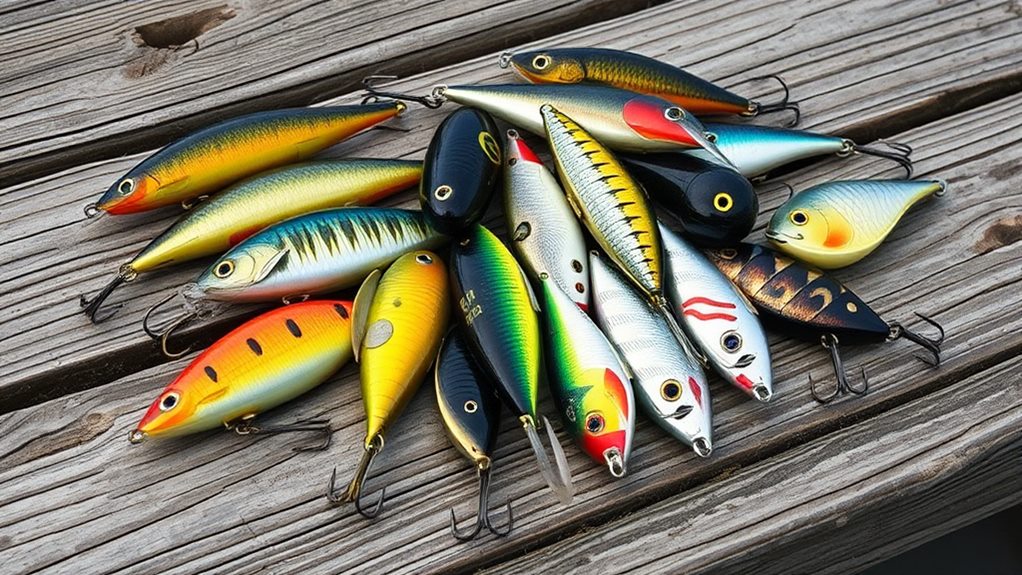
A bass angler's arsenal isn't complete without mastering reaction baits – those dynamic lures designed to trigger instinctive strikes through movement and vibration. When you're looking to catch bass in various conditions, these lures can be your secret weapon for enticing even the most reluctant fish to bite.
Similar to the aggressive nature of redfish near marshes, bass will often strike reaction baits with explosive force during low light conditions.
Water clarity plays an essential role in your bait selection. In clear conditions, you'll want to stick with natural colors that mimic local prey, while murky water calls for brighter or darker colors that create more visible contrast.
For deep-diving action, the Little John DD can reach impressive depths of 20 feet, making it perfect when bass fishermen need to target fish holding in deeper summer sanctuaries.
Don't overlook the shallow water potential of topwater reaction baits, especially in grassy areas. Lures like the Horny Toad and Bronzeye Frog can trigger explosive strikes from bass hunting near the surface.
The key to success is varying your retrieval speed – sometimes a steady retrieve works best, while other times an erratic, stop-and-go motion will trigger those instinctive strikes you're after.
Perfecting Your Casting Accuracy
Having the right reaction baits won't matter if you can't place them exactly where the bass are hiding. As experienced bass anglers know, casting accuracy is vital for getting those bites, especially when you're targeting fish near docks, stumps, or other structures. To improve your success rate, you'll need to master different casting angles and perfect your technique.
| Casting Tips | Benefits |
|---|---|
| Practice Side Angles | Better dock shooting |
| Reduce Splash | Less spooked fish |
| Use Wind Direction | Increased distance |
| Master Roll Casts | Better accuracy |
When you're covering water effectively, your casting accuracy becomes even more important. Start by selecting a lightweight rod setup that gives you better control, and spend time practicing different casting techniques. You'll want to develop that fundamental muscle memory, which will serve you well when you're trying to catch fish in challenging conditions.
Remember to adjust your technique based on wind conditions – casting with the wind can greatly improve your accuracy and distance. By focusing on accurate casting and regularly practicing your skills, you'll find yourself hitting those target zones more consistently, leading to more successful fishing trips.
Adapting Techniques Throughout The Day
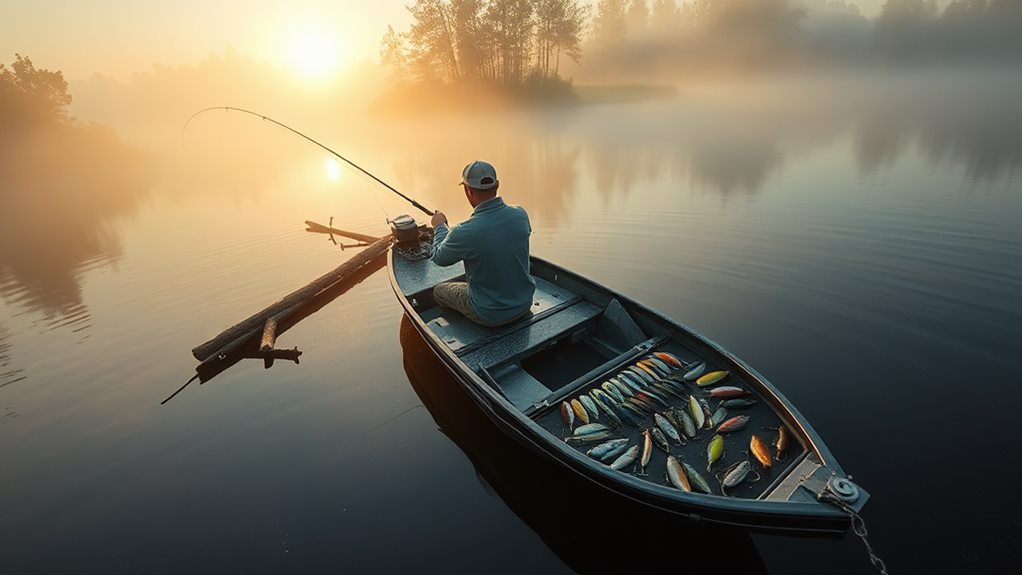
Bass fishing demands constant adaptation as conditions shift throughout the day. To consistently catch bass, you'll need to modify your approach based on changing light, temperature, and fish behavior patterns. Your time on the water will be most productive when you're willing to switch tactics as conditions evolve.
During early morning and evening hours, when light levels are low, reaction bites are often your best bet. Try working crankbaits with varying retrieval speeds to trigger aggressive strikes from active fish.
As the day progresses and conditions change, you'll want to adapt your presentation accordingly. When faced with calm conditions or less aggressive fish, don't hesitate to switch to finesse techniques. Shaky heads and Texas rigs can entice even the most reluctant bass to bite.
Keep a close eye on water temperature and current patterns throughout your fishing session, as these factors greatly influence bass behavior.
Remember to adjust your retrieval speed based on the time of day – quicker retrieves often work better during peak feeding periods in the morning, while slower presentations might be necessary during midday lulls.
Understanding Bass Feeding Behaviors
Successful anglers know that mastering the art of adaptation leads naturally to a deeper grasp of bass feeding behaviors.
You'll quickly discover that bass fall into three distinct groups: enthusiastic biters, reluctant feeders, and those that need some convincing. Understanding these patterns is essential if you want to catch a lot of fish consistently.
Water temperature and light conditions play major roles in determining when and how bass feed. During low-light periods, you'll find that reaction baits can trigger explosive strikes, even from less-active fish. It's like flipping a switch – suddenly, those lazy bass transform into aggressive predators!
To maximize your success, remember these key points:
- 90% of successful bass fishing depends on choosing the right bait for the current feeding behavior
- Watch for surface activity and schooling patterns
- Adjust your approach based on seasonal changes
- Pay attention to environmental triggers that spark feeding
Maximizing Your Time On Water

Making the most of every minute on the water can dramatically improve your fishing success. When you spend more time fishing, you'll naturally become more attuned to subtle changes in fish behavior and environmental conditions that make you a better angler. It's not just about logging hours – it's about making those hours count.
To maximize your time on the water, focus on these key strategies:
- Practice different techniques consistently to build versatility
- Study specific fishing spots and learn their seasonal patterns
- Monitor your lure action throughout the day
- Join tournaments or fish with experienced anglers
You'll find that catching bass becomes more consistent when you concentrate on understanding particular locations rather than randomly searching new spots.
Keep a close eye on your lure's movement and maintain focus – those subtle bites often come when you least expect them.
Consider participating in co-angler events or local tournaments. Not only will you learn from pros, but you'll also develop new skills under pressure.
Frequently Asked Questions
What Is the Secret to Bass Fishing?
You'll catch more bass by understanding their behavior, choosing the right bait, fishing during low light, mastering different retrieval techniques, and adapting to seasonal patterns. There's no single secret—it's about combining these elements.
How to Catch Bass Every Time?
You won't catch bass every time, but you'll increase success by fishing during dawn/dusk, targeting structure, matching lures to conditions, and staying patient. Focus on water temperature and weather patterns for best results.
What Is the Most Successful Bass Lure?
You'll find spinnerbaits are the most successful bass lure overall. They're versatile, work in various conditions, and effectively mimic injured baitfish. You can fish them shallow or deep for consistent strikes.
How Do You Catch Big Bass Consistently?
You'll catch big bass consistently by fishing during low light hours, targeting cover-rich areas, and using reaction baits in ideal temperatures. Focus on seasonal patterns and practice your casting accuracy for better results.

